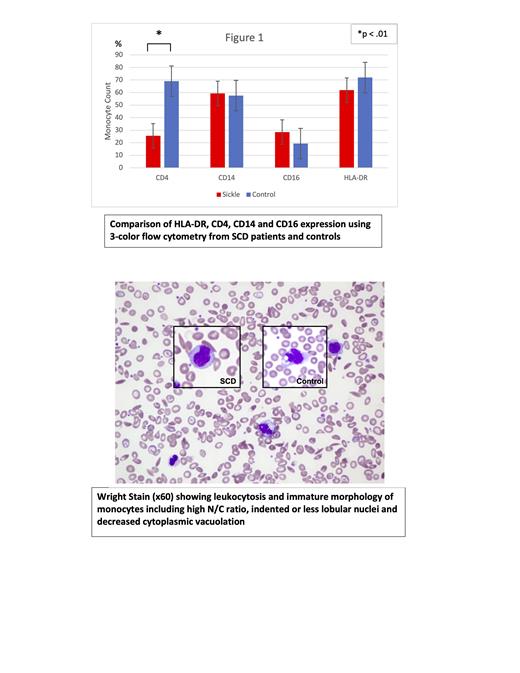Sickle cell disease (SCD) is marked by episodic vaso-occlusive crisis (VOC). Painful VOC is the leading cause of emergency room visits and hospitalization in SCD, contributing heavily to the morbidity and mortality of this disease. Recurrent VOC creates a pro-inflammatory state that induces phenotypic alterations in the innate immune system. This inflammation-induced immune profile remodeling results in chronically active monocytes and neutrophils that antagonizethe vascular endothelium and further predispose SCD patients to VOC. While the mechanism of neutrophil involvement in VOC has been elucidated, less is known about the pathologic role of monocytes. Monocytes are of particular interest to VOC pathophysiology because they are especially malleable to inflammatory signaling. Indeed, inflammatory disease states such as COPD, obesity and atherosclerosis are known to influence monocyte development and alter monocyte subpopulations. Recently, nonclassical monocytes (CD14 dimCD16 +) with high heme oxygenase-1 expression have been shown to have a critical role in preventing VOC, generating renewed interest in monocytes as a therapeutic focus in SCD. In this study, we describe the monocyte subsets found in SCD patients during VOC by performing immunophenotypic flow cytometric, enzymatic, and morphologic analysis on peripheral blood obtained during hospitalization for VOC. Herein, we add to the growing body of evidence suggesting aberrant monocyte populations underpin VOC pathophysiology. We found that SCD monocytes during VOC possess an immature phenotype as demonstrated by 1) decreased CD4 positivity (p < .01), 2) low α-naphthyl butyrate esterase (ANBE) expression, and 3) naïve morphologic features (high nuclear/cytoplasmic ratio, indented or less lobular nuclei, and decreased cytoplasmic vacuolization). We additionally found an increase in CD14 +CD16 -CD4 - monocytes (p < .01), a subset associated with the impaired immune response of post-trauma patients. Interestingly, we also found a large proportion of CD14 +CD4 -HLA-DR - monocytes which, under normal circumstances, are exclusively found in neonates (p < .01). Finally, we report an increase in nonclassical monocytes (CD14 dimCD16 +), providing further evidence for the connection between this subset and the molecular mechanisms driving VOC. Taken together, these findings suggest that SCD patients in VOC deploy relatively immature monocytes that possess a lower capacity for antigen presentation, likely contributing to the immune dysfunction observed in SCD.
Disclosures
No relevant conflicts of interest to declare.


This feature is available to Subscribers Only
Sign In or Create an Account Close Modal